May 4, 2007
 Catan officially launched on Wednesday. We didn't write a story then because we figured that our previous coverage from earlier this week already kept you on top of the news. Call us self-critical but we didn't want to sound like a loudspeaker bullhorn pumping out the consumer propaganda. At least not until we had a chance to wrap our hands around the game so we could give you our impressions, and let you know if it’s worth the 800 points on Xbox Live (~ $10.00 US).
Catan officially launched on Wednesday. We didn't write a story then because we figured that our previous coverage from earlier this week already kept you on top of the news. Call us self-critical but we didn't want to sound like a loudspeaker bullhorn pumping out the consumer propaganda. At least not until we had a chance to wrap our hands around the game so we could give you our impressions, and let you know if it’s worth the 800 points on Xbox Live (~ $10.00 US).
The Good and the Bad
Catan Live is a great translation of the classic board game. Those who have played the Settlers of Catan enough to know the details of the game backwards and forwards will be very much satisfied with their play experience on Catan Live. However, those players who are unfamiliar with the Settlers of Catan board game might need to a bit of convincing to see where all the excitement is at.
This isn't really because Catan has any obvious shortcomings that shoot up a red flare of FAILURE. However as the first release of a board game on the Live service, this title might have a tough time luring a console gaming audience into the world of Catan – where most of the excitement comes from the outcome of a pair of dice - when many of the Xbox Livites thirst after explosions, chainsaw kills, gibs and car wrecks. Even worse, it's a bit confusing to determine exactly what's going in a game of Catan given the game's UI - the graphical presentation of card trades and gathered resources is done well, but it fades very quickly in order to keep the game moving at a good pace.
We think players new to board gaming like to learn by observation, keeping track of other players behave in certain situations, and that's pretty difficult to do for a beginner of Catan on Xbox Live. We could see how players new to Eurogames - who might be itching for any reason to dismiss the game - could get confused and lose interest almost immediately due the game's hasty presentation.
It took a while even for us to get used to what was going on. For instance, in a face to face game, there’s a part of each Settlers when people call out which resources they gathered after a dice roll. We’ve become used to this being a good thirty second production where excitedly demand their well-earned resource cards, etc. The audible and physical presence of the in-person Settlers makes each turn an event, and thus easy to remember ‘who got what?’ even from a few turns ago. But in the console Catan game, the whole resource awarding phase ends in about 3 seconds, and it takes a few games to realize that you’re not paying enough attention to a very important part of the game that almost seems to be brushed aside for the sake of efficiency.
 Continue reading: " Catan Xbox Live Impressions"
Continue reading: " Catan Xbox Live Impressions"
Critical Gamers Staff at
Permalink

December 8, 2006
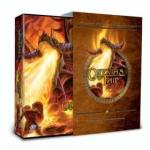 The Onyxia's Lair Raid Deck [Amazon,ToyWiz] for the World of Warcraft Trading Card Came has shipped to stores, and most retailers have finally received enough copes to meet the preorder demand. We picked up our copy a few days ago, and we were like kids on Christmas morning. Immediately we tore into to our copy and ran the game through its paces.
The Onyxia's Lair Raid Deck [Amazon,ToyWiz] for the World of Warcraft Trading Card Came has shipped to stores, and most retailers have finally received enough copes to meet the preorder demand. We picked up our copy a few days ago, and we were like kids on Christmas morning. Immediately we tore into to our copy and ran the game through its paces.
The cards themselves are gorgeous - with some of the best artwork in the game to date. The deck comes in carrying-case that matches the same design as the World of Warcraft TCG Starter Decks [Amazon,ToyWiz]. The black dragon Onyxia is represented by an over sized Hero card, just as those that shipped with the starter decks, and her deck of cards is the same size as the normal WoW playing cards. But they sport a gold framing around them because they're special.
Now - if we were to sum up our experience in two concise words which lack any sort of elaborate details, then we'd have to say: "too easy".
Fortunately we're not dismissive jerks. We feel the game merits a far more detailed and constructive criticism than that, and we're more than willing to break-down our experience a bit more. Perhaps whatever you read here can make the Onyxia's experience a bit more challenging for yourselves than it was for us, and hopefully a bit more fun.
 Continue reading: "World of Warcraft TCG Onyxia Raid Deck Review"
Continue reading: "World of Warcraft TCG Onyxia Raid Deck Review"
Critical Gamers Staff at
Permalink

November 3, 2006
 We had our first WoW Trading Card Game rumble last night. Five of us grabbed a Starter Deck [Amazon] and 3 extra Booster Packs [Amazon] each. Five hours later, in the dark hours of the morning, we reluctantly decided to call it a night. At 1:15 am - on a weeknight - we went our separate ways to sleep off the giddiness, but as early as 1:50 am some of us were already emailing each other with exciting WoW possibilities. No Joke.
We had our first WoW Trading Card Game rumble last night. Five of us grabbed a Starter Deck [Amazon] and 3 extra Booster Packs [Amazon] each. Five hours later, in the dark hours of the morning, we reluctantly decided to call it a night. At 1:15 am - on a weeknight - we went our separate ways to sleep off the giddiness, but as early as 1:50 am some of us were already emailing each other with exciting WoW possibilities. No Joke.
Was all the hype for the World of Warcraft TCG worth the wait? You bet your sweat bippy it was.
 Continue reading: "World of Warcraft TCG Review"
Continue reading: "World of Warcraft TCG Review"
Critical Gamers Staff at
Permalink

October 25, 2006
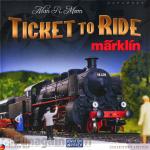
Ticket to Ride: Marklin [Amazon,Funagain] is hands-down fantastic. Days of Wonder once again shows that they can produce a well balanced, high-quality title with staying power. Don't let the happy train model cover fool you - although this is a game chalk-full of content geared toward train enthusiasts (Marklin is gigantic train hobbyist company out of Germany), it is absolutely not a niche game. Ticket to Ride: Marklin has enough depth and replayability for the strategy gamer in you, and yet is light and simple enough that families shouldn't feel at all nervous about throwing its board down onto the dining room table to play a round with their kids.
In Marklin players collect and play train cards of various colors to construct a strong rail network connecting the towns of Germany. Then, once their empire is established, players can send passengers along their network, collecting points for each city they visit on their way. The turns are fast. The game is colorful, dynamic, and most importantly - a blast to play. Here's why:
 Continue reading: "Review: "Ticket to Ride: Marklin""
Continue reading: "Review: "Ticket to Ride: Marklin""
Critical Gamers Staff at
Permalink

September 26, 2006
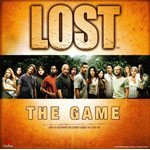 Almost everyone in our group is a fan of the TV Show Lost (almost). There's the quirkiness of the island, the crass wordsmithing of Sawyer's castaway nicknames, the looming arrogance of the Dharma Initiative, and the puzzling question -- how the heck can all these attractive people have so many freakin' coincidences?
Almost everyone in our group is a fan of the TV Show Lost (almost). There's the quirkiness of the island, the crass wordsmithing of Sawyer's castaway nicknames, the looming arrogance of the Dharma Initiative, and the puzzling question -- how the heck can all these attractive people have so many freakin' coincidences?
We had doubts when we first heard that Lost had a board game treatment: "Lost the Game" [Amazon, Target]. Most of the time TV to board game tie-ins really lack .. goodness. They're often designed by marketers to lure customers into a purchase, but when the game is unwrapped the unknowing customer finds a monopoly board with cobranding stickers hastily slapped over the orignial Park Place property names .
Marketers realize that most board game purchases are made by the customer's opinion of the cover or media tie-in. There really hasn't be a long standing resource for consumers to research or read a review off of the shelf games. What's changing these days is that people are actually becoming choosy with their board game purchases. Customers now read sites like this one to search for good family board games, or are meeting on gaming nights and talking with their friends about different titles and genres within the gaming scene (which is not nearly as dorky as what it once was). The culture is growing, too, and now has an internal dialogue which keeps gamers from becoming hoodwinked, and that population now reaches across s gap that once separated them from the mainstream. American game marketers are awakening to realize that board gaming is no longer a commodity market.
Our initial impression before getting our hands on the product was that Lost The Game is another rushed-to-market title. But as we dove deeper into the game's history we found prerelease coverage suggesting the title was designed by a gamer instead of a by boardroom of suits. According to the game's designer himself ( Keith Tralins interview ) Lost The Game draws inspiration from such greats as The Settlers of Catan, Talisman and Magic: The Gathering. The coupling of elements from these games seems risky and unclear, yet potentially clever. Most conservative marketers probably wouldn't have signed-off on spending time and money investing on a risky idea, but times are changing, and here in our hands sits the end product "Lost The Game".
Does the Lost mass market tie-in board game designed by a gamer, for gamers, live up to the standards of the best games on the market today? Could Lost The Game actually be the Missing Link between American marketing and Eurogaming excellence?
 Continue reading: ""Lost the Game" Review"
Continue reading: ""Lost the Game" Review"
Critical Gamers Staff at
Permalink

August 31, 2006
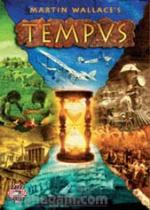 People have likened Tempus [Funagain] to a simplified version of a civilization style game - namely, the game Advanced Civilization. We like to think the game falls in line with this other analogy: Tempus is to Civilization, as stuffed French toast (at I-Hop) is to a traditional French breakfast.
People have likened Tempus [Funagain] to a simplified version of a civilization style game - namely, the game Advanced Civilization. We like to think the game falls in line with this other analogy: Tempus is to Civilization, as stuffed French toast (at I-Hop) is to a traditional French breakfast.
Tempus wraps a sugary crepe around the complexities of a social evolution and conquest game like Civilization, and pours a gobs of syrup on top so that anyone will give it a try. In fact, Tempus simplifies so much into a sweet gooey essence that a lot of the inspired flavor is lost. Although the soul of the game is still anchored in the dynamics of growing societies, almost nothing in the gameplay or in the pieces sells the feeling of social evolution. Don't get us wrong - the game definitely satisfies, but there's very little to instill a feeling that you're leading a society out of caves, through feudalism, into the age of exploration and finally the modern era.
Tempus does have some mechanics of technological progression, but only in the sense that the entire world's technology level is slowly evolving as a whole. Each turn begins with the world technology meter going up one 'age' (writing then farming, etc), which increases the power of each of the payer's actions (increased movement distance, increased number of actions players can make, increased population growth, etc). Players can gain a technological advantage over their competitors, but for only one turn at a time. At the end of the turn everyone catches up with each other, and the playing field is once again leveled.
That brief technological edge is determined at the start of each turn. The game has a linear technology track, and each spot on that track is tied to a resource type on the game board. Those players who start the turn with the most units occupying that resource type will gain a technological boost - for one turn their level of technology is actually the next level on the progression track. Depending on the technology age, this could give them a short boost to hand size, unit stacking limit, movement distances, etc. At the end of the turn the track is normalized (everyone is the same technology level again), the next technology resource type is checked, and a new technology advantage is given.
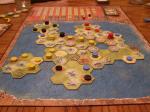 The resources required for the progression of society varied greatly in human history, and this is well reflected in Tempus and is an important mechanic of the game. Moving your society into place to adapt and take advantage of the various resources and technological boons will take careful consideration. And even with plans in place, the progression of your civilization never seems the least bit inevitable - an opponent may win the tech race one turn, launching his units over land and sea faster than you can move your tribe, and they might beat you to the resources that you had planned to conquer three turns in the future.
The resources required for the progression of society varied greatly in human history, and this is well reflected in Tempus and is an important mechanic of the game. Moving your society into place to adapt and take advantage of the various resources and technological boons will take careful consideration. And even with plans in place, the progression of your civilization never seems the least bit inevitable - an opponent may win the tech race one turn, launching his units over land and sea faster than you can move your tribe, and they might beat you to the resources that you had planned to conquer three turns in the future.
One last thing we'd like to go over is the game cards. Each card has special text that can be played at any time your turn. The cards are mainly boosters to the normal actions a player can take. For example, if a player chooses to Have Babies as one of their turn actions, then the Medicine card can be played to increase the number of units placed. The cards also have a colored background matching the various resources on the board. In this way the cards can also be used to boost the resources accumulated for the technology race, OR to increase the combat strength of your unit when fighting on a space that contains that resource. The multipurpose cards can be very confusing at first, as there are times when you it's confusing if you have to match resource types with the card and the target or not. However, once the state of confusion is broken, the multipurpose aspect becomes a huge strength of the game. Should you use cards to boost the power of a particular action this turn thus increasing your civilization's infrastructure, or do horde them to increase your resources for a technological edge? Or do you save them for stronger defense, or to push an attack into enemy territory?
To us, weighing these decisions is the essence of the civilization game genre. Is Tempus [Funagain] worth it after all of the historical theme and complexity has been stripped bear? So far, we strongly nod yes. Unlike its predecessors, a game of Tempus can easily be wrapped up in an hour to an hour of a half (instead of three to twelve hours), and there's a lot of strength in that. And thanks to Tempus' random board layout, no two games will play the same.
Critical Gamers Staff at
Permalink

August 1, 2006
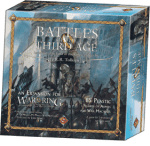 A soggy thunderstorm swept through New England this weekend, and we thought it would be the perfect time to crack open War of the Ring's [Amazon, Funagain] new expansion The Battles of the Third Age [Funagain]to give it a go. We met at six in the evening to setup the Battle for Rohan (one of 3 new scenarios in the Expansion), and got to playing. Before long we were elbows deep in one of the most engrossing war game experiences we've ever had, and nobody in our group noticed (or cared) when the clock stuck ten, then 11, 12, and 1 am.
A soggy thunderstorm swept through New England this weekend, and we thought it would be the perfect time to crack open War of the Ring's [Amazon, Funagain] new expansion The Battles of the Third Age [Funagain]to give it a go. We met at six in the evening to setup the Battle for Rohan (one of 3 new scenarios in the Expansion), and got to playing. Before long we were elbows deep in one of the most engrossing war game experiences we've ever had, and nobody in our group noticed (or cared) when the clock stuck ten, then 11, 12, and 1 am.
Now that the dust has settled from our wargaming marathon, we've collected our thoughts on the game experience. Read on for our criticisms and accolades over the expansion's revised combat system, the new pieces and boards, and how succesfully they all mesh together into the new War of the Ring gameplay experience.
 Continue reading: "Hands On: War of the Ring Battle For Rohan"
Continue reading: "Hands On: War of the Ring Battle For Rohan"
Critical Gamers Staff at
Permalink

June 23, 2006
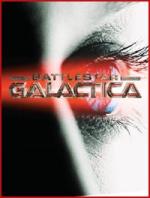 We had a chance to sit down with our new Battlestar Galactica Collectible Card Game Starter Sets [IconUSA]. First impression, right away - cool packaging. The starter sets come in an elongated rectangular box, with the edges cut off to make the trimming octoganal (just like all of the paper in the show). The box holds two mini decks of 31 cards. One deck is themed with the militaristic Commander Adama, who faces-off against President Roslin who leads the other mini-deck (we'll get into more details about how these themes play in a minute). The game also has a tutorial that walks you through a deliberate sample game of mini-deck versus mini-deck. The tutorial assumes the cards are straight out of the package and in their orignial order, but if you've shuffled them around in excitement then the game comes with directions on how to put them back in their original order. Too nice.
We had a chance to sit down with our new Battlestar Galactica Collectible Card Game Starter Sets [IconUSA]. First impression, right away - cool packaging. The starter sets come in an elongated rectangular box, with the edges cut off to make the trimming octoganal (just like all of the paper in the show). The box holds two mini decks of 31 cards. One deck is themed with the militaristic Commander Adama, who faces-off against President Roslin who leads the other mini-deck (we'll get into more details about how these themes play in a minute). The game also has a tutorial that walks you through a deliberate sample game of mini-deck versus mini-deck. The tutorial assumes the cards are straight out of the package and in their orignial order, but if you've shuffled them around in excitement then the game comes with directions on how to put them back in their original order. Too nice.
Okay, so the enjoyment and usefulness of the packaging and instructions is fleeting in the whole scheme of things. The cards are what make this game, and if they don't hold up then there really isn't a point? With that - we have some good news, and some bad news.
 Continue reading: "Hands On: Battlestar Galactica Collectabe Card Game"
Continue reading: "Hands On: Battlestar Galactica Collectabe Card Game"
Critical Gamers Staff at
Permalink

June 16, 2006
 Despite the genre's name, there are some parties that aren't conducive to party-gaming. You know what we're talking about - when your gathering is going great, and everyone lounging, laughing and cruising through a PBR 12 pack, you wouldn't dare mention the idea of breaking out a "box" and setting up a board.
Despite the genre's name, there are some parties that aren't conducive to party-gaming. You know what we're talking about - when your gathering is going great, and everyone lounging, laughing and cruising through a PBR 12 pack, you wouldn't dare mention the idea of breaking out a "box" and setting up a board.
We've been there. Selling the idea of a game to a ragtag group of people can be near-impossible. Yet whenever someone mentions 'Celebrity', a game that we've played at quite a few late-night occasions with various groups, everybody's ear perks up.
Why? Because Celebrity has something for everybody. It can break the ice between strangers, cure disease, stop war, and align the planets into orbits of peace an harmony. Yeah - it's got a lot of things going for it.
Here are the rules:
1: Split the group into two teams. The game lends itself for some great Guys vs Girls gameplay.
2: Everyone gets five strips of paper, a pencil, and a few minutes to jot down some random celebrities. It doesn't matter how these celebrities became famous -- they just have to be widely known people. Say... movie stars, sports stars, world leaders, fictional characters, astronauts, televangelists, muppets, you get the idea.
 Continue reading: "Celebrity - A Free Party Game"
Continue reading: "Celebrity - A Free Party Game"
Critical Gamers Staff at
Permalink

June 1, 2006
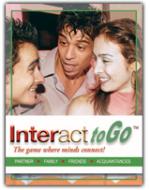
Overview
Interact toGo is produced by Interact Games Ltd which has released a series of games with the goal of uniting intra office cultures (aka team building). Interact toGo extends the franchise by opening up audience to groups of friends and family.
The Company Line: Interact toGo is a card game that is fun, thought-provoking and entertaining. The purpose is to predict your opponent’s answer and the reason WHY behind it. That’s where the real fun begins!
Your opponent is your spouse, partner, neighbor or friend! Find out something new or different about the people in your life, those you think you know well and those you just met. Build relationships, value other’s perspectives and stimulate interesting dialogue while gaining points along the way.
The Gameplay
Playing a round of toGo is quite simple. A player picks a card off the top of the deck and reads the question aloud. The card also supplies multiple choice answers, which are also read aloud. The Question Reader selects an answer in secret, and jots down a description of "why" he/she chose the answer. It's the job of the other players to guess which answer the Question Reader chose (by writing it down), and also to guess the answer to the "why?" portion of the question. Then, everyone's responses are revealed, and 1 point is awarded to players with the correct answer to the multiple choice question, and 1 more point is awarded to players who correctly guessed "why".
Critique
The design is as about as streamlined as you can get, but let's dive into the nitty gritty details of the game's execution.
Interact toGo ships with 100 questions cards. The questions themselves are somewhat diverse in subject matter, but they all fit the same cookie cutter template - the players select their favorite multiple choice answers from a list of "what if" scenarios. "If I could be a constant on a game show, which would I chose, and why?", "If I could travel back in time and meet a historical figure, would would I chose, and why?" These aren't exactly the deepest questions, so if you're familiar with the folks you're playing with then it isn't difficult to deduce their answer (the "why" follow-up question still might be a challenge, however). The game also lacks a strong set of moral questions, which is a surprise since "family" is one of the intended audiences listed on the front of the box.
The Interact toGo website promises laugh-out-loud gameplay, but the questions themselves aren't exceedingly funny. The title also lacks an obvious game-mechanic that would provide humor. All of the hilarious moments stem from the "why" portion of the question, so it falls on the players' shoulders to tickle each other's funny bone. This usually occurs the moment a question that was intended for a woman falls into the lap of a man, or vice versa, or when a player doesn't even try to answer the "why" part of a question, but instead creates a completely outlandish response. That's when the fun really starts.
Finally, the act of writing the "why" to every answer provides some very unique, custom-tailored, and yes - potentially humorous responses. But in our overly-critical ways we found that it can simply take too long, and it slows down the pace of the game a bit too much . If there were more humorous or biting questions in the game then the downtime wouldn't be such a bad thing, but in the end the game's pace and content combine to slow down the game a bit too much. This is especially true when Interact toGo is compared against other shallower, but faster-paced titles in the party-quiz genre (Apples to Apples).
Conclusion
Interact toGo provides an unparalleled level of personal-depth to the social trivia experience. This is the game's major strength (and the seemingly the flaghship design decision that inspired the game). The potential for humor is there, but it often comes in sharp spikes harbored between longer lulls. The game simply isn't always funny or entertaining enough to compensate for the long down-time between rounds.
Also, we would have liked to have seen a bit more edge to the questions - perhaps circumstances where the player is forced to select the lesser of two evils, or questions that tested the players' morales. The addition of a few deeper questions cards might have generated additional hooks for humor which otherwise don't exist. Humor is key here because it more effectively obscures the game's slower pace while still stressing the title's strength for interpersonal-discovery.
In a world of passive social entertainment where TVs blast their waves through the living room, over cell phones, and in the back seats of minivans, the interpersonal design behind Interact toGo is a breath of fresh air. But in the end we liked the groundwork of ideas more than the actual execution. People who enjoy games in the social trivia genre will most likely enjoy the experience of this game, but the title isn't a sure-fire winner for everyone.
Interact toGo is available for purchase from the game's official website.
3 stars out of 5 Our Critical Raiting System
Critical Gamers Staff at
Permalink

